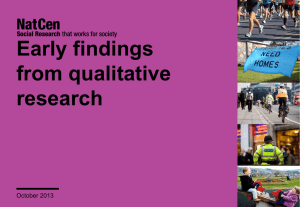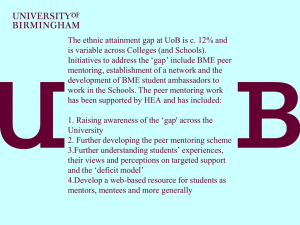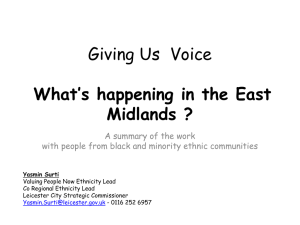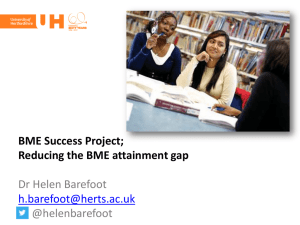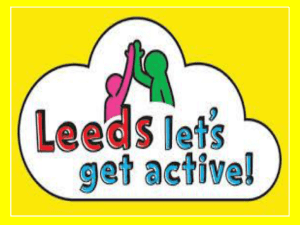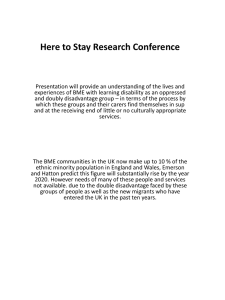What is Haamla? - Leeds Teaching Hospitals NHS Trust
advertisement
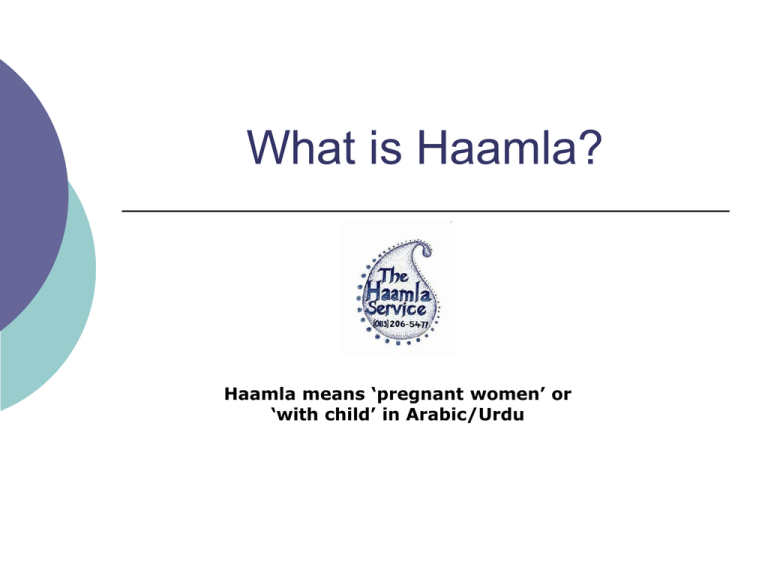
What is Haamla? Haamla means ‘pregnant women’ or ‘with child’ in Arabic/Urdu The Haamla Team Co-Ordinator Specialist BME Midwife Doulas Haamla Midwives Haamla Maternity Support Workers Background Haamla was launched by Leeds Family Health Service Authority (FHSA) in 1994. To address maternity inequalities in Black Minority Ethnic communities. Initially focussed on women from Asian subcontinent. In 1997 Haamla was mainstreamed as part of the Maternity Services at Leeds Teaching Hospitals NHS Trust. Providing a service in Leeds for 19 years for BME women and their families. Background Specialist BME midwife Sarah Bennett joined Haamla in 2009. The team expanded with a Haamla Midwifery Team in 2010 which provides: Maternity care for women in process of seeking asylum and for asylum seekers who have been denied asylum and are destitute in Leeds; Travellers and other vulnerable BME women. The team deliver care across the city, predominantly in the women’s homes Haamla Midwifery Team support the Haamla antenatal classes across the city Why do we have Haamla? 2013 LTHT Stillbirth review demonstrated that women from BME groups are overrepresented in still birth data 2011 Saving Mothers Lives Report demonstrated that 42% of Direct maternal deaths occurred in women of Black and minority ethnic groups and 24% of Indirect deaths, giving an overall percentage of 31% of women who died of maternal causes declaring themselves to be from non White ethnic groups Why do we have Haamla? To improve access and outcomes in maternity care. BME women are more likely to access care after 12 weeks of pregnancy e.g. in Leeds. 2009/10 41% Chinese women booked late 2011/12 only 75% Bangladeshi women had accessed a midwife by 13 weeks pregnancy Why do we need Haamla? Inform and empower women to make informed choices during their care. Compliment the care received by Health Professionals in hospital/community. Increased breastfeeding rates amongst BME groups. Reduce infant mortality amongst BME vulnerable women. Who do we support? BME Women Asylum Seekers Migrants Bereavement Haamla Supports No birth support Refugees Overseas Students Isolated BME Population in Leeds BME population has increased by 83% since 2001 Census Pakistani is the largest BME community 16% ‘White Other’ has doubled since 2001 due to migration from Eastern European Mixed Ethnic groups have doubled since 2001. ie, Black African and white has increased two fold. Decrease in people from Irish backgrounds 18% and slight decrease from Carribean backgrounds. Source: 2011 Census of Population of Leeds BME Population in Leeds Population of Leeds: 85.1% White British 0.9% White Irish 0.1% White Gypsy/Irish Traveller 2.9% White Other BME population in Leeds has increased from 8.2% (2001) to 14.9% in 2011. Combine with above white Irish/gypsy traveller gives total BME population for city of 18.9% (2001; 10.8%) Source: 2011 Census of Population of Leeds What do we provide? Befriending Advocacy Home visits Sign post FGM Clinics Culturally Sensitive service Doula Antenatal Groups Accessibility Interpreters Bi-lingual staff Ward Visits Volunteer Doula Project - 2010 Mothers in Exile – Women delivering alone http://www.womenshealthmatters.or g.uk/downloads.html NHS Leeds funding DH replication of Hull Goodwin Volunteer Doula Project Vulnerable BME Women Recruitment of Bi-lingual volunteers The Doula Training Accredited to Level 2 and Level 3 with Open College Network 12 weeks training consisting of: 4 x 3 hour sessions Sessions covering antenatal/post natal role and birth, cultural diversity, communication skills, etc…. Delivery Suites Tours to both sites LGI & SJUH ½ day Child Protection Basic Awareness ½ day Domestic Violence Awareness 2 day Active Birth Course and 2 day Breastfeeding course Reflective, Interactive, Ongoing additional training The Doula Role To offer emotional and physical support during : Antenatal Through Birth and Postnatal support Research suggests reduced risk of medical intervention, speedier recovery, reduction in postnatal depression. Doula Role A Cochrane review in 2007 regarding continuous support for women during labour concluded that women who had continuous intrapartum support were likely to have a slightly shorter labour, were more likely to have a spontaneous vaginal birth and less likely to have intrapartum analgesia or to report dissatisfaction with their childbirth experiences and continuous intrapartum support was associated with greater benefits when the provider was not a member of the hospital staff, when it began early in labour and in settings in which epidural analgesia was not routinely available. (Hodnett ED, Gates S, Hofmeyr GJ, Sakala C. Continuous support for women during childbirth. Cochrane Database of Systematic Reviews 2007, Issue 3. Art. No.: CD003766. DOI: 10.1002/14651858.CD003766.pub2.) Volunteer Doulas Antenatal Groups “Services should be accessible to all women and be and be designed to take full account of their individual needs including different language, cultural, religious and social needs or particular needs related to disability, including learning disability.” (Maternity Matters DH 2007). Multi Disciplinary Working Destitution/ Food Shelter Refugee Council Health Community Groups Haamla Interpreting Children’s Centres Social Care Mental Health How to refer to the service How to refer to Haamla Midwifery Team Email to:leedsthtr.haamlamidwives@nhs.net Fax: 0113 2066461 Send to: Haamla Office, ANC, Gledhow Wing 04 SJUH Tel: 0113 2065477 0113 2066392 Contact the Team Haamla Office Antenatal Clinic Level 04 Gledhow Wing SJUH. Tel:- 0113 2065477 0113 2066392
